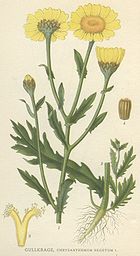
Glebionis segetum
Encyclopedia

Glebionis
Glebionis is a small genus of flowering plants in the family Asteraceae, native to Europe and the Mediterranean region. The species were formerly treated in the genus Chrysanthemum, but a recent ruling of the International Code of Botanical Nomenclature has resulted in that genus being redefined to...
, probably native only to the eastern Mediterranean region. Common names include Corn Marigold and Corn Daisy.
It is a herbaceous
Herbaceous
A herbaceous plant is a plant that has leaves and stems that die down at the end of the growing season to the soil level. They have no persistent woody stem above ground...
perennial plant
Perennial plant
A perennial plant or simply perennial is a plant that lives for more than two years. The term is often used to differentiate a plant from shorter lived annuals and biennials. The term is sometimes misused by commercial gardeners or horticulturalists to describe only herbaceous perennials...
growing to 80 cm tall, with spirally arranged, deeply lobed leaves
Leaf
A leaf is an organ of a vascular plant, as defined in botanical terms, and in particular in plant morphology. Foliage is a mass noun that refers to leaves as a feature of plants....
5–20 cm long. The flower
Flower
A flower, sometimes known as a bloom or blossom, is the reproductive structure found in flowering plants . The biological function of a flower is to effect reproduction, usually by providing a mechanism for the union of sperm with eggs...
s are bright yellow, produced in capitulae
Inflorescence
An inflorescence is a group or cluster of flowers arranged on a stem that is composed of a main branch or a complicated arrangement of branches. Strictly, it is the part of the shoot of seed plants where flowers are formed and which is accordingly modified...
(flowerheads) 3.5-5.5 cm diameter, with a ring of ray florets and a centre of disc florets.
It is widely naturalised
Naturalisation (biology)
In biology, naturalisation is any process by which a non-native organism spreads into the wild and its reproduction is sufficient to maintain its population. Such populations are said to be naturalised....
outside of its native range, colonising western and central Europe
Europe
Europe is, by convention, one of the world's seven continents. Comprising the westernmost peninsula of Eurasia, Europe is generally 'divided' from Asia to its east by the watershed divides of the Ural and Caucasus Mountains, the Ural River, the Caspian and Black Seas, and the waterways connecting...
with early human agriculture
Agriculture
Agriculture is the cultivation of animals, plants, fungi and other life forms for food, fiber, and other products used to sustain life. Agriculture was the key implement in the rise of sedentary human civilization, whereby farming of domesticated species created food surpluses that nurtured the...
; it can be an invasive weed
Weed
A weed in a general sense is a plant that is considered by the user of the term to be a nuisance, and normally applied to unwanted plants in human-controlled settings, especially farm fields and gardens, but also lawns, parks, woods, and other areas. More specifically, the term is often used to...
in some areas.
It was formerly treated in the genus Chrysanthemum
Chrysanthemum
Chrysanthemums, often called mums or chrysanths, are of the genus constituting approximately 30 species of perennial flowering plants in the family Asteraceae which is native to Asia and northeastern Europe.-Etymology:...
, but under a recent decision of the International Code of Botanical Nomenclature, that genus has been redefined with a different circumscription to include the economically important florist's chrysanthemum.
In Gaelic the plant was known as Brenanbroi which translates as that which rotteth corn.
The Corn Marigold must have been a serious weed during the 13th century in Scotland as a law of Alexander II states that if a farmer allows so much as a single plant to produce seed in amongst his crops then he will be fined a sheep.
A Marigold was the emblem of Mary Queen of Scots.
In Crete
Crete
Crete is the largest and most populous of the Greek islands, the fifth largest island in the Mediterranean Sea, and one of the thirteen administrative regions of Greece. It forms a significant part of the economy and cultural heritage of Greece while retaining its own local cultural traits...
, Greece
Greece
Greece , officially the Hellenic Republic , and historically Hellas or the Republic of Greece in English, is a country in southeastern Europe....
, the leaves and the tender shoots of a variety called neromantilida (νερομαντηλίδα) are eaten raw in salads or browned in hot olive oil
Olive oil
Olive oil is an oil obtained from the olive , a traditional tree crop of the Mediterranean Basin. It is commonly used in cooking, cosmetics, pharmaceuticals, and soaps and as a fuel for traditional oil lamps...
by the locals.

